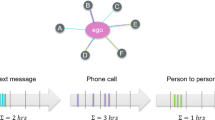Abstract
Usenet may be regarded as the world’s largest and fastest growing conversational application. In 1988 there were fewer than 500 newsgroups. Current estimates vary, but at the time of our data collection in December 1996, there were over 17,000 newsgroups, with approximately 3 million users worldwide (Harrison, 1994). This growth has been achieved without any centralized organization or governing body (King, 1997). The ubiquity of Usenet, and the fact that it supports conversations between hundreds or even thousands of participants, provides the opportunity to study what we term mass interaction. However, we currently lack basic data about Usenet interactions. The current paper analyses over 2.15 million messages produced by 659,450 people in 500 representative newsgroups collected over 6 months. We provide descriptive data about newsgroup demographics, communication strategies, and interactivity. We then derive predictions from the common ground model of communication to test predictions about how these parameters interact.
Access this chapter
Tax calculation will be finalised at checkout
Purchases are for personal use only
Preview
Unable to display preview. Download preview PDF.
Similar content being viewed by others
References
Baym, N. (1993) Interpreting soap operas and creating community: Inside a computer-mediated fan culture, Journal of Folklore Research, 30, 143–176.
Berlin, L., Jeffries, R., O’Day, V., Paepcke, A., and Wharton, C. (1993) Where did you put it? Issues in the design and use of a group memory. In Proceedings of CHI'93, 33–30.
Clark, H. (1992) Arenas of language use. University of Chicago Press, Chicago.
Cohen, P. (1995) Empirical methods for artificial intelligence, Boston, MIT Press.
Constant, D., Sproull, L., and Kiesler, S. (1996) The kindness of strangers, Organizational Science, 7, 119–135.
Granovetter, M. (1973) The strength of weak ties. American Journal of Sociology, 78, 1360–1380.
Harrison, M. (1994) The Usenet handbook. O’Reilly, Boston.
Horton, M. (1993): Rules for posting to Usenet, news.misc, news.answers., FTP at rtfm.mit.edu.
King, J. Grinter, R and Pickering, J. (1997) The rise and fall of Netville. In S. Kiesler (Ed.), Culture of the internet. Erlbaum, NJ.
Kollock, P and Smith, M (1996) Managing the Virtual Commons In S. Herring (Ed.) Computer-Mediated Communication, John Benjamins, Philadelphia.
Kraut, R. and Attewell, P (1997) Media use in a global corporation. In S. Kiesler (Ed.), Culture of the Internet, Erlbaum, NJ.
Kraut, R., Fish, R., Root, B. and Chalfonte, B (1992) Informal communication in organizations. In R. Baecker (Ed.), Groupware and Computer Supported Co-operative Work, 287-314, Morgan Kaufman, CA.
Markus, M (1990) Towards a critical mass theory of interactive media. In J. Fulk and C. Steinfield (Eds.), Organizations and Communication Technology, Sage, CA.
O’Conaill, B., Whittaker, S., and Wilbur, S (1994) Conversations over video conferences, Human Computer Interaction, 8, 389–428.
Smith, M (1997) Measuring the social structure of the Usenet, Unpublished paper, University of California, Los Angeles.
Sproull, L., and Kiesler, S (1991) Connections, Boston, MIT Press.
Sutton, L (1994) Gender, power, and silencing in electronic discourse on Usenet, Proceedings of the 20th Berkeley Linguistics Society, University of California, Berkeley.
Whittaker, S. (1996) Talking to strangers: an evaluation of the factors affecting electronic collaboration, In Proceedings of CSCW96, ACM Press, NY.
Whittaker, S. and Sidner, C (1996) Email overload: exploring personal information management of email. In Proceedings of CHI96, ACM Press, NY.
Editor information
Editors and Affiliations
Rights and permissions
Copyright information
© 2003 Springer-Verlag London
About this chapter
Cite this chapter
Whittaker, S., Terveen, L., Hill, W., Cherny, L. (2003). The Dynamics of Mass Interaction. In: Lueg, C., Fisher, D. (eds) From Usenet to CoWebs. Computer Supported Cooperative Work. Springer, London. https://doi.org/10.1007/978-1-4471-0057-7_4
Download citation
DOI: https://doi.org/10.1007/978-1-4471-0057-7_4
Publisher Name: Springer, London
Print ISBN: 978-1-85233-532-8
Online ISBN: 978-1-4471-0057-7
eBook Packages: Springer Book Archive




